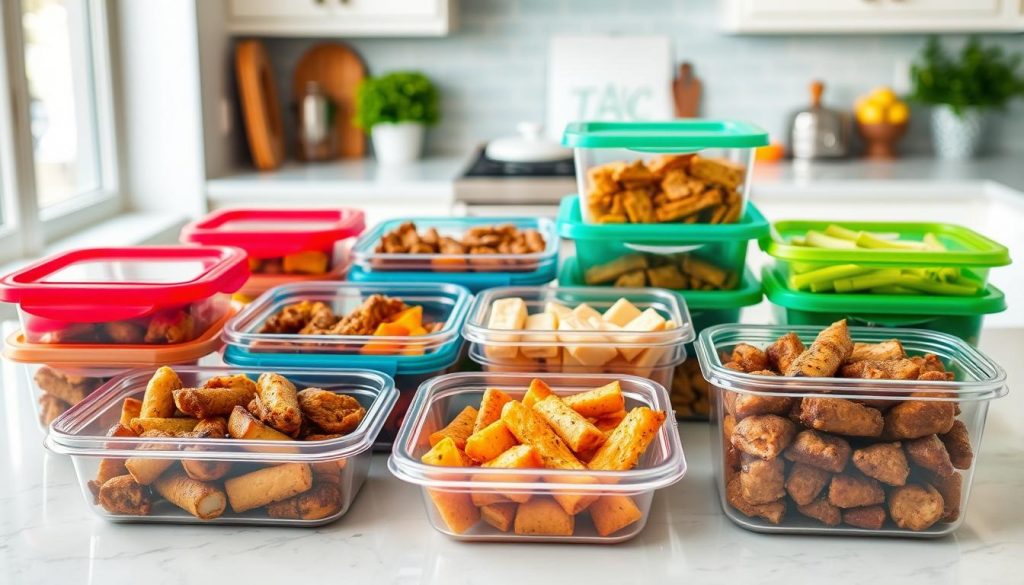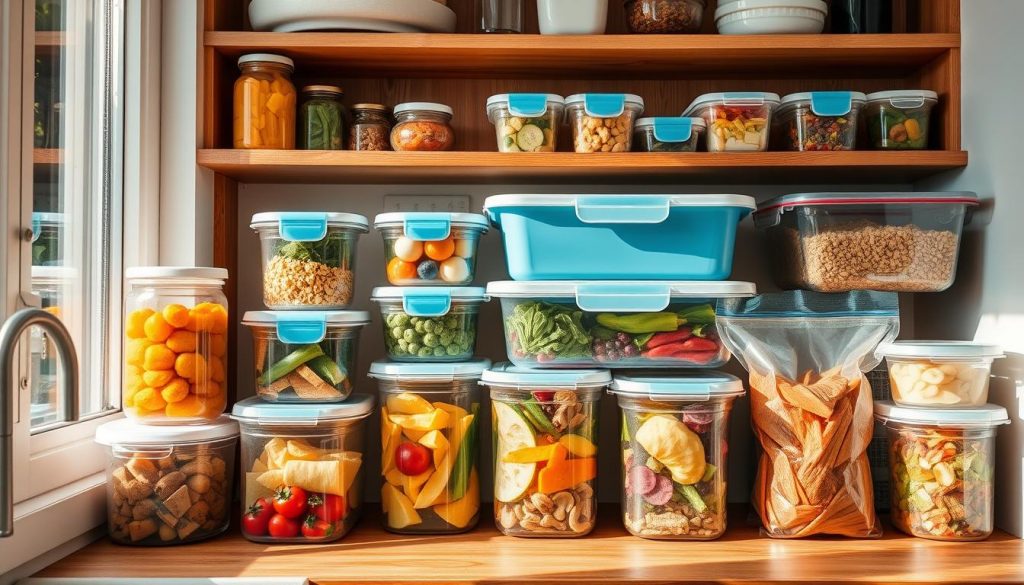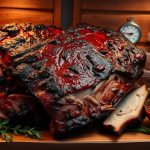Barbecue leftovers are a treat, but how long can you keep them? This guide explores barbecue storage and food safety. We’ll help you make the most of your grilled treasures.
We’ll cover proper refrigeration and how to spot spoilage. Our tips apply to pulled pork, ribs, and brisket. Let’s learn how to keep your BBQ fresh and safe to eat.
Key Takeaways
- Proper refrigeration is crucial for BBQ food safety
- Different BBQ meats have varying shelf lives in the fridge
- Use airtight containers for optimal barbecue storage
- Learn to spot signs of spoilage in bbq leftovers
- Follow safe reheating practices for stored BBQ
- Avoid common storage mistakes to maintain food quality
Understanding BBQ Food Storage Basics
Proper storage of BBQ leftovers keeps them flavorful and safe. Let’s dive into the must-know tips for storing your tasty barbecue meals.
Temperature Control Fundamentals
The right temperature is vital for BBQ storage. Bacteria grow fast between 40°F and 140°F, the danger zone. Refrigerate BBQ within two hours of cooking to stay safe.
If it’s over 90°F outside, chill your food within one hour. This quick action prevents harmful bacteria growth.
Proper Storage Containers
Pick the best containers to keep your BBQ fresh. Airtight options prevent air exposure and lock in moisture. Glass or BPA-free plastic containers are great choices.
Avoid metal containers for acidic foods. They can react and affect the taste of your BBQ.
Refrigeration Best Practices
Follow these tips for optimal refrigeration:
- Set your fridge temperature below 40°F
- Store BBQ in shallow containers for quick cooling
- Place containers on upper shelves where it’s coldest
- Use within 3-4 days for best quality
| Storage Method | Temperature | Max Storage Time |
|---|---|---|
| Refrigeration | Below 40°F | 3-4 days |
| Freezing | 0°F or below | 2-3 months |
Master these food storage basics to keep your BBQ safe and delicious. Good temperature control and proper containers are key.
Smart refrigeration practices help you enjoy your barbecue long after grilling. Follow these tips for the best results.
How Long Does BBQ Last in the Fridge
Proper BBQ storage is vital for safety and taste. Let’s explore storage times, spoilage signs, and tips for longer-lasting barbecue.
Storage Time for Different BBQ Meats
Storing meat correctly keeps it flavorful and safe. Check out this guide for common BBQ meats:
| BBQ Meat | Refrigerator Storage Time |
|---|---|
| Beef Brisket | 3-4 days |
| Pulled Pork | 3-4 days |
| Grilled Chicken | 3-4 days |
| Smoked Ribs | 3-4 days |
Signs of Spoilage
Keep an eye out for these spoilage indicators:
- Off-putting odor
- Slimy texture
- Mold growth
- Color changes
Extending Shelf Life Tips
Use these methods to keep your BBQ fresh longer:
- Cool quickly before refrigerating
- Use airtight containers
- Store at 40°F or below
- Separate meats from other foods
These guidelines help maintain BBQ safety and flavor. If you’re unsure, it’s best to discard the food.
Don’t risk getting sick from spoiled meat. Always prioritize food safety when storing BBQ.
Safe Storage Guidelines for Different BBQ Types
Storing BBQ can be tricky. Let’s explore food safety guidelines for various meats. These tips will help you manage leftovers like a pro.
Beef BBQ needs careful handling. Store it in shallow containers and refrigerate within two hours of cooking. Properly chilled, it lasts 3-4 days.
For longer preservation, freeze beef BBQ for up to 2-3 months. Pork BBQ follows similar rules. Refrigerate quickly and use within 3-4 days.
If freezing pork, it stays good for up to 2-3 months. Always thaw in the fridge, never on the counter.
Chicken BBQ requires extra caution. In hot weather, refrigerate within 1 hour of cooking. Use within 3-4 days or freeze for up to 4 months.
Always reheat chicken to 165°F (74°C) internal temperature. Seafood BBQ is the most delicate. Eat within 1-2 days when refrigerated.
If freezing seafood, use within 3 months for best quality. Store in airtight containers to prevent odor transfer.
| BBQ Type | Refrigerator Storage | Freezer Storage |
|---|---|---|
| Beef | 3-4 days | 2-3 months |
| Pork | 3-4 days | 2-3 months |
| Chicken | 3-4 days | 4 months |
| Seafood | 1-2 days | 3 months |
These are general guidelines for BBQ storage. Trust your senses and judgment when deciding if leftovers are safe to eat.
Properly Packaging Leftover BBQ
Good packaging keeps leftover BBQ tasty and safe. Let’s look at ways to keep your grilled food fresh.
Airtight Container Options
Airtight containers are great for storing leftovers. Glass or plastic containers with tight lids keep food fresh. Choose containers that fit meat snugly to reduce air exposure.

Wrapping Techniques
Wrapping BBQ leftovers properly is important. Use foil or plastic wrap to seal meats tightly. Wrap sandwiches and burgers individually to keep them crisp.
Double-wrap ribs to keep moisture in. This also prevents freezer burn for long-term storage.
Labeling and Dating Systems
A good labeling system helps you track leftovers. Use labels or tape to mark containers with key info.
- Contents (e.g., “Smoked Brisket”)
- Date stored
- Estimated use-by date
This method helps you organize leftovers and track freshness easily.
These packaging tips will make your BBQ leftovers last longer. They’ll taste great the second time around. Good packaging keeps food tasty and safe to eat.
Reheating Stored BBQ Safely
Reheating leftover BBQ can be tricky. We aim to keep flavors intact while ensuring food safety. Let’s explore effective BBQ reheating methods that maintain taste and texture.
Use an oven or grill for optimal food reheating. Preheat to 225°F and wrap your meat in foil. This helps retain moisture.
Place the wrapped BBQ in a baking dish. Heat until it reaches safe cooking temperatures.
- Beef and pork: 145°F
- Chicken and turkey: 165°F
- Fish: 145°F
Microwave reheating is quick but can dry out your BBQ. Place meat on a microwave-safe plate and cover with a damp paper towel. Heat in 30-second intervals, checking temperature between each.
“Always use a meat thermometer to ensure your reheated BBQ reaches safe internal temperatures.”
Store BBQ in shallow, airtight containers and refrigerate within two hours of cooking. When ready to reheat, let it sit at room temperature for 10-15 minutes first.
Reheated BBQ is safe to eat for 3-4 days after initial cooking. Trust your senses – if it smells off or looks discolored, discard it.
Common Storage Mistakes to Avoid
Food safety errors often occur when storing BBQ leftovers. Let’s explore common pitfalls and how to avoid them. This will help keep our meals safe and delicious.
Temperature Danger Zone Errors
The temperature danger zone is a major food storage risk. Bacteria thrive between 40°F and 140°F. Cool BBQ quickly and store it at the right temperature to prevent spoilage.
Proper food storage techniques are vital for maintaining food safety and quality. These methods help preserve the taste and prevent bacterial growth.
Cross-Contamination Risks
Cross-contamination can happen when we’re not careful with storage methods. Keep raw and cooked meats separate. Use different utensils for each to prevent harmful bacteria from spreading.
Improper Container Usage
Choosing the right storage containers is crucial for preserving BBQ. Airtight containers help prevent bacteria growth and maintain freshness. Glass or BPA-free plastic containers are best for storing leftovers in the fridge.

| Common Mistake | Potential Risk | Solution |
|---|---|---|
| Leaving BBQ at room temperature | Bacterial growth in danger zone | Refrigerate within 2 hours |
| Storing raw and cooked meats together | Cross-contamination | Use separate containers |
| Using damaged or non-airtight containers | Faster spoilage | Invest in quality storage containers |
Avoiding these mistakes ensures our BBQ stays safe and tasty longer. Proper storage is key to enjoying leftovers without compromising flavor or safety.
Freezing BBQ for Long-Term Storage
Freezing BBQ extends its shelf life, allowing you to enjoy smoked meats later. Let’s explore the best freezing methods and how to maintain quality during storage.
Freezing Methods
Wrap meat tightly in plastic wrap, then aluminum foil to prevent freezer burn. This double-layer method locks in flavor effectively.
Store saucy BBQ in airtight containers, leaving space for expansion. Label each package with the date and contents for easy tracking.
Thawing Procedures
Safe thawing is crucial for maintaining food quality and safety. The best method is thawing slowly in the refrigerator overnight.
For quicker results, use the cold water method. Submerge sealed packages in cold water, changing it every 30 minutes.
Quality Preservation Tips
To maintain frozen meat quality, follow these tips:
- Freeze BBQ at peak freshness
- Keep freezer temperature at 0°F (-18°C) or below
- Use vacuum-sealed bags for best results
- Consume within 2-3 months for optimal flavor
| BBQ Type | Freezer Storage Time | Best Thawing Method |
|---|---|---|
| Pulled Pork | 3-4 months | Refrigerator |
| Beef Brisket | 2-3 months | Refrigerator |
| Smoked Chicken | 4-6 months | Cold Water |
| BBQ Ribs | 4-6 months | Refrigerator |
Follow these guidelines to enjoy your BBQ favorites year-round. You’ll maintain their delicious flavors and textures for future meals.
Food Safety Tips for BBQ Handling
Safe food handling is vital for a great BBQ. These tips will help you prepare safely and keep your kitchen clean.
Always start with clean hands. Wash them with soap and warm water for 20 seconds. Do this before and after handling raw meats.
Keep raw and cooked foods separate. Use different cutting boards for raw meats and veggies. Never put cooked food on a plate that held raw meat.
- Marinate meats in the refrigerator, not on the counter
- Use a food thermometer to ensure meats reach safe internal temperatures
- Refrigerate leftovers within two hours of cooking
Control temperatures to prevent bacteria growth. Keep cold foods below 40°F and hot foods above 140°F. This stops the danger zone where bacteria thrive.
“The key to food safety lies in the details. Every step matters, from preparation to storage.”
Clean and sanitize surfaces often, especially after handling raw meats. This practice greatly reduces the risk of food-borne illness.
| Food Item | Safe Internal Temperature | Rest Time |
|---|---|---|
| Beef, Pork, Lamb | 145°F (63°C) | 3 minutes |
| Ground Meats | 160°F (71°C) | None |
| Poultry | 165°F (74°C) | None |
These safety tips will make your BBQ tasty and safe. Remember, preventing food-borne illness is better than dealing with it later.
Conclusion
Proper BBQ storage keeps leftovers safe and delicious. Control temperature to prevent foodborne illness. Store barbecue in airtight containers and refrigerate within two hours of cooking.
Label and date your stored BBQ to track freshness. This helps avoid eating spoiled food. When reheating, ensure leftovers reach 165°F (74°C) to eliminate bacteria.
Freeze BBQ for extended storage life. Use appropriate thawing methods to maintain quality. These practices help preserve flavor and safety.
By following these guidelines, you’ll enjoy tasty barbecue for days after cooking. Safe storage lets you savor your BBQ longer without worry.




